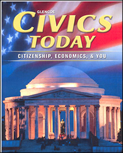
Civics Today Citizenship, Economics, & YouChapter 7: The Executive BranchChapter OverviewsArticle II of the Constitution describes the qualifications for and the duties of the president of the United States. The Framers also created an indirect system for electing the president called the Electoral College. Although very little is said about the vice president in the Constitution, the most important part of the job is being ready to take over if anything should happen to the president. The job of the president can be divided into seven major roles: chief executive, chief diplomat, commander in chief, legislative leader, head of state, economic leader, and party leader. As chief diplomat the president establishes the country's foreign policy, or plan for dealing with other nations. The basic goal of American foreign policy is national security. The president has the power to make treaties with foreign governments. These treaties are then subject to approval by the Senate. The president also appoints ambassadors and directs foreign aid. When necessary, he may use his power as commander in chief to send the U.S. military into action in various parts of the world. Through the nation's history the job of president has grown. Today the Executive Office of the President employs about 2,000 people and the executive branch altogether employs several million. The White House staff are those who work closest to the president on a day-to-day basis. The cabinet is a group of advisers that includes the heads of the 15 top-level executive departments. Political appointees and civil service workers carry out the work of these departments. Most career government employees were hired under the civil service system on the basis of open competitive examinations and merit. |  |















